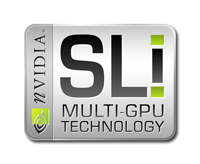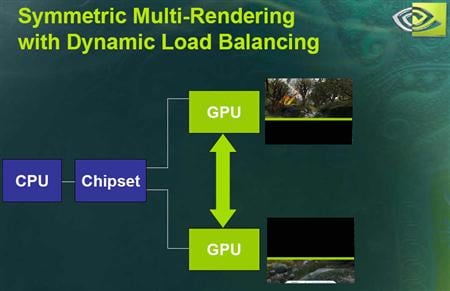NVIDIA's Multi-GPU Technology - SLI, it's baaack!
Is it really SLI?

Let's take a walk down memory lane, shall we? Where were you in 1999? If you were into the technology scene, especially personal computing, most likely you were scampering about like Chicken Little, wondering what you would do when the sky fell at the end of the year, as the clocks ticked over to the year 2000. The Y2K support and compliance industry was in full bloom, as we all thought our computers, mainframes and networks would somehow spontaneously combust due to the fact that our BIOS firmware, operating systems and application software couldn't handle the roll-over into the new millennium.
In addition to worrying about your soon too be possessed PC, if you were an enthusiast, you probably also were happily gaming on a pair of Voodoo 2 cards, in a Scan Line Interleaving setup, or "SLI" for short. Well, SLI is back again today, sort of. When NVIDIA bought out 3dfx in December of 2000, they also bought the intellectual property, patents and branding of the company that was once a driving force in 3D Graphics for the PC.
 |
|
|
3dfx's SLI technology,used two graphics processors in a parallel processing setup where one chip drew even lines of an image and the other chip drew the odd lines of the image. This in many ways was a simple way of increasing available fill rate, geometry setup and load-balancing of rendering workloads on the graphics subsystem. And because it was working at the scan line level, it was fairly easy to manage timing of rendering and output to a display, so artifacts were non existent. NVIDIA's new breed of SLI however, isn't really SLI at all. The company is just retaining the name and branding of the technology, since many folks will identify with the parallel processing concept that was made so popular by their one time competitor and now assimilated symbiotic partner, 3dfx. CLICK ANY IMAGE FOR AN ENLARGED VIEW Taking a page from the book of Wicked3D/Metabyte (remember them?), NVIDIA is actually employing a lesser known technology for their Multi-GPU NV45 implementations, more a kin to Metabyte's "PGC" or Parallel Graphics Configuration approach. In this implementation,both chips work on different sections of a frame. One chip renders the top half of the screen, while the other chip renders on the bottom half of the screen. This approach has the potential for rendering workloads to be unbalanced between the two GPUs, however. One half of the screen can have fewer polygons to render than the other. For example, in an outdoor environment, the top half of the screen can have much less detail to render in the sky area, versus the bottom ground half of the screen. As you can see in the above nature scene from 3DMark03, the top half of the frame has some detailed rendering to do but the bottom half may have significantly more workload involved due to hundreds of individual blades of grass that are all set in motion. This is where NVIDIA's new software algorithms will come into play. The host CPU and chipset will manage the work load distribution evenly between each GPU. In addition, NVIDIA's NV45 architecture also incorporates an inter-GPU communications protocol that allows the two cores to signal status between them, for more efficient multi-chip rendering results. |







